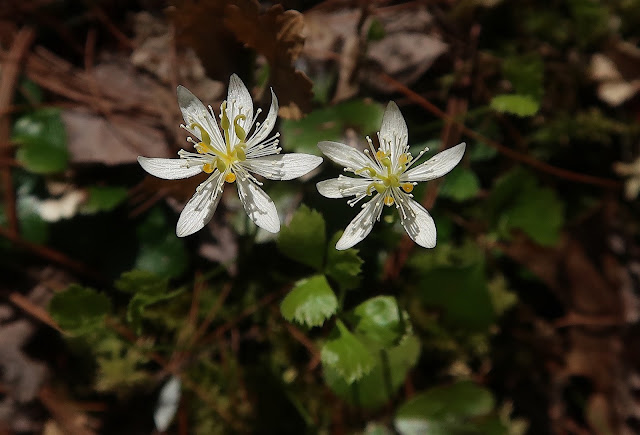As the warm weather continues, I've been running all over the county, trying to greet -- before they disappear -- the flowers that came into bloom during my absence. It's not for nothing they're called spring ephemerals! On yet another gorgeous shirt-sleeve warm day yesterday, I did a quick tour of parts of the Bog Meadow Brook Nature Trail, entering the trail through the Meadowbrook Estates spur. This part of the trail leads down a steep slope from upland woods to a boardwalk that crosses a wetland full of Skunk Cabbage, native ferns, and other plants that prefer a damp habitat.
Two species of Horsetail (Equisetum spp.) share this habitat with many other wetland-loving plants without dominating the vegetation the way some other species of Equisetum do. I was lucky to catch both the fertile (brown) and sterile (green) early shoots of Field Horsetail (E. arvense) together in one easily photographed location. The fertile stalks bear spores in those cone-like growths that top their segmented stems, and once the spores ripen and are shed, these stalks will wither away and disappear completely. The small green sterile plants will continue to grow taller and spread their branches wide, photosynthesizing throughout the growing season.
Nearby was a second species of Horsetail, the Woodland Horsetail (E. sylvaticum), distinguished by the way its whorls of leaves are multi-branched. Another distinctive feature of this species is that it bears its fertile cones (called strobili) atop green sterile stalks, rather than on separate stalks. These cones will fall off, once the spores have been dispersed, and the branching whorls will grow longer, presenting a very lacy appearance when the plant is mature.
The trail at this point leads directly toward an open swamp, which today was a field of gold, with thousands of clumps of Marsh Marigold (Caltha palustris) loaded with bright-yellow blooms.
Here's a closer look at those gorgeously colorful blooms:
Sharing the shallow standing water with those masses of Marsh Marigold were mats of tiny green leaves. Seeing how thickly they covered the mud, it's easy to understand how this wetland plant called Golden Saxifrage (Chrysosplenium americanum) earned its other common name of Water Carpet.
What I don't understand is what inspired the "golden" part of its common name. (Or the chrysosplenium part of its scientific name.) A close look at its miniature flowers reveals some red dots that I believe are its staminate parts. A bit later, some tiny yellow dots -- the pistillate parts -- will also appear, but they will be virtually invisible to standing-height onlookers and not lend a golden color to the plant mass as a whole. Hmmmm.
Back on the trail, an old railroad right-of-way still underlaid with railroad ties, I walked along a tiny stream that closely follows the trail for much of its distance. I was grateful for the watercourse behind these stems of Miterwort (Mitella diphylla), which allowed the tiny fringe-petaled flowers to stand out against the dark water.
That same dark water provided a similar favor to the flowers of Toothwort (Cardamine diphylla) growing along its bank.
When I walked in the Skidmore woods earlier this week, all the Trout Lilies (Erythronium americanum) there were withered and gone, but here in the woods along Bog Meadow Trail, these beautiful yellow lilies were still in their glory.
I was grateful I hadn't missed the bloom-time of the lovely Goldthread (Coptis trifolia), which is usually among our earliest bloomers. There've been other years when I've missed its brief appearance entirely, but today there were multitudes spangling the edge of the trail like stars in the sky, backed by their glossy evergreen leaves.
Another plant that was offering a trailside bounty was Dog Violet (Viola labradorica [formerly conspersa]), blooming abundantly in colorful numbers.
Without a closer look, it would be easy to confuse this violet with the Common Blue Violet, but Dog Violet bears its leaves on its flower stems, while the Common Blue has basal leaves only. Another distinguishing feature is the presence of sharply toothed stipules surrounding the leaf nodes on the Dog Violet. This feature has proved a helpful mnemonic for me: sharp teeth suggest "canines," which in turn suggest "dog." Hey, whatever works! Violets are so confusing, we need all the help we can get to accurately identify and remember them.
Another abundant floral display: the tiny white blooms of Northern White Violet (Viola pallens) dotting a hummock of Tussock Sedge within a trailside pool. We have another small white violet that is virtually indistinguishable by folks like me, except that I know this particular violet likes it wet, while the other one likes it dry. (And it blooms a bit later. Usually.)
Here's a closer look at one of those violets, displaying the wide, nearly round shape of its leaves. Another distinguishing feature, I've been told.
The most colorful violet of the day was saved for last. As I made my way down a sunny, sandy bank toward my car, I was greeted by the deep-purple blooms of Ovate-leaved Violet (Viola sagittata var. ovata). Despite its wooly leaves and stems that could protect it from cold, this is a violet that likes it hot and dry. Such a lovely flower, with blooms that are bigger than its leaves, at least when it first emerges. I'm glad I didn't miss seeing it.
















No comments:
Post a Comment